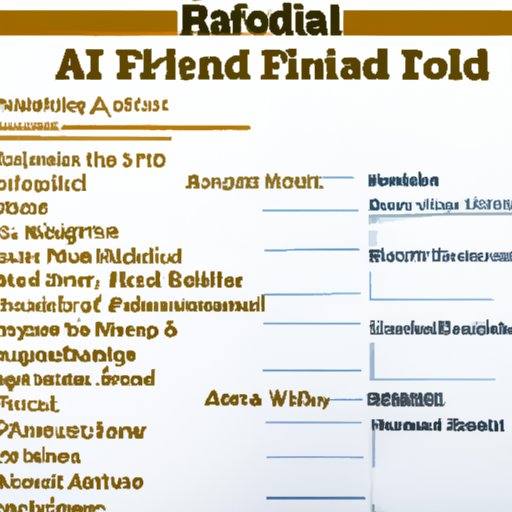Introduction
The financial aid process can be overwhelming and confusing for students and their families. One of the most important documents in this process is the financial aid award letter. It outlines the amount of money that a college or university plans to provide to a student to cover their tuition and other educational expenses.
The purpose of this article is to explain in detail what a financial aid award letter looks like and how to read and interpret it. We will also discuss some of the key components of the letter and provide a comprehensive breakdown of each one.
A Step-by-Step Guide to Understanding Your Financial Aid Award Letter
The first step in understanding your financial aid award letter is to get an overview of what it includes. The letter typically begins with an introduction that provides the student’s name, the school they are attending, and the academic year for which the award applies. It then outlines the different types of financial aid available and the amounts awarded.
The next step is to familiarize yourself with the different components of the letter. Generally, these include a breakdown of the cost of attendance, grants and scholarships, loans, and work-study. Each component contains specific information about the amount of money available to the student and how it can be used.
Finally, it is important to understand what each component means and how to make sense of the numbers provided. The following sections will provide a detailed breakdown of each component and explain what information you need to know.

What You Need to Know About Your Financial Aid Award Letter
When reviewing your financial aid award letter, there are a few important pieces of information to look for. First, the letter should list the total cost of attendance for the academic year. This includes tuition and fees, room and board, books and supplies, transportation, and any other related expenses.
Second, the letter should also include a breakdown of the grants and scholarships available to you. These may come from the college or university, the government, or other sources. Make sure to note the deadline for accepting or declining these awards.
Third, the letter should outline the loans available to you. These may include federal loans, private loans, or both. Be sure to review the terms and conditions of each loan carefully before deciding which one to accept.
Finally, the letter should include information about any work-study programs you may be eligible for. Work-study programs allow students to earn money while attending school, which can help cover educational expenses.

A Comprehensive Breakdown of a Financial Aid Award Letter
Now that we have discussed the different components of a financial aid award letter, let’s take a closer look at each one. Below is a comprehensive breakdown of the information included in each section.
The Cost of Attendance
The cost of attendance outlines the total amount of money it will cost you to attend school for the academic year. This includes tuition and fees, room and board, books and supplies, transportation, and any other related expenses. It also includes estimates for personal expenses such as clothing and entertainment.
Grants and Scholarships
Grants and scholarships are free money that does not need to be repaid. They are typically awarded based on financial need, academic performance, or other criteria. Your financial aid award letter will outline the amount of money you have been awarded and the source of the funds.
Loans
Loans are funds that must be repaid with interest. Your financial aid award letter will outline the loans available to you, including federal loans and private loans. Be sure to review the terms and conditions of each loan before deciding which one to accept.
Work-Study
Work-study programs allow students to work part-time while attending school. The funds earned can help cover educational expenses. Your financial aid award letter will outline the amount of money you are eligible to earn through the program and the types of jobs available.
How to Read and Interpret Your Financial Aid Award Letter
Once you have a basic understanding of the different components of your financial aid award letter, it is time to start reading and interpreting the numbers. Here are a few tips to help you make sense of the information:
- Understand the Terms: Before you begin to interpret the numbers, it is important to understand the terminology used in the letter. For example, “Cost of Attendance” is the total amount of money it will cost to attend school for the academic year, while “Net Cost” is the amount you will be responsible for paying out of pocket.
- Calculate Your Bottom Line: Once you have a good grasp on the terminology, it is time to calculate your bottom line. Subtract the amount of grants and scholarships you have been awarded from the total cost of attendance to determine your net cost. Then subtract any loans you plan to accept from the net cost to determine the amount you will be responsible for paying out of pocket.
- Ask Questions: If you have any questions about the information included in your financial aid award letter, don’t hesitate to reach out to the financial aid office for clarification. They are there to help you understand and make the best decisions for your situation.
Conclusion
The financial aid award letter is an important document that outlines the amount of money a college or university plans to provide to cover tuition and other educational expenses. This article provided a comprehensive breakdown of the different components of the letter and explained what information you need to know. Understanding your financial aid award letter is key to making the best decisions for your situation.
By taking the time to review and understand your financial aid award letter, you can make sure you are getting the most out of your education. Knowing what to look for and how to interpret the numbers can help you make informed decisions and save money in the long run.
(Note: Is this article not meeting your expectations? Do you have knowledge or insights to share? Unlock new opportunities and expand your reach by joining our authors team. Click Registration to join us and share your expertise with our readers.)
